The working hours are from 10:00 AM to 9:00 PM,
There is no work on Tuesdays
As for the “Retro Cafe”, it operates during the Planetarium’s working days from 10:00 AM to 8:00 PM.
Contact number: +7 (495) 221-76-90
Planetarium JSC © 2017. Address: Moscow, Sadovaya-Kudrinskaya str. 5, bldg. 1
Shooting Stars from the Orion Constellation
Astronomers anticipate a maximum of 20 meteors every hour. Clear skies are ideal for observing Orionids, which can be seen from midnight to sunrise above the southeastern horizon. The conditions for observing the Orionids in 2022 are quite favorable.
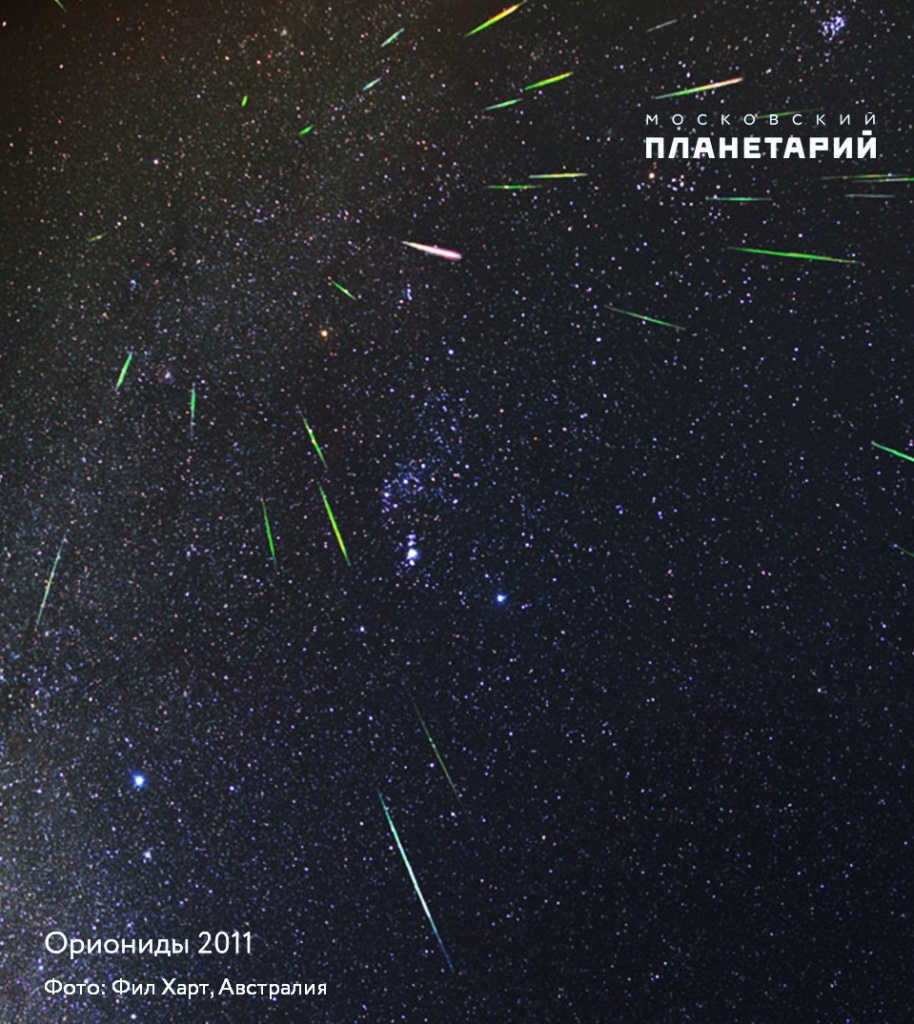

The maximum of the Orionid meteor shower, which originates from the Orion constellation, will occur on October 20th. This annual event takes place in October, with the highest activity usually observed around October 21st. The Orionids are a moderately strong meteor stream that produces approximately 20 meteors per hour at its peak. The activity of the Orionids tends to remain relatively consistent for several nights following the peak.
A Quick Overview of the Orionids 2022 (www.imo.net):
- The peak of the Orionids will happen on the night of October 20-21, 2022
- On this night, the Moon will be 21% full, as it is close to the new moon (October 25, 2022), and its brightness will not interfere with observations.
- Radiant: 06:21 +15.6° The radiant will be visible from 21:09 until dawn.
- The number of meteors at the zenith per hour (ZHR) is 20.
- The speed of the meteors is 66 km/sec.
- The meteors are bright, fast, and white in color.
- The parent object of these meteors is comet 1P/Halley.
- Observations of these meteors are made from local midnight to dawn over the southeastern horizon.
The Orionids originate from the comet 1P/Halley
The Orionids are formed from a cloud of particles that were left behind by the well-known comet Halley (1P/Halley), which has been observed since ancient times and is one of the most famous periodic comets.
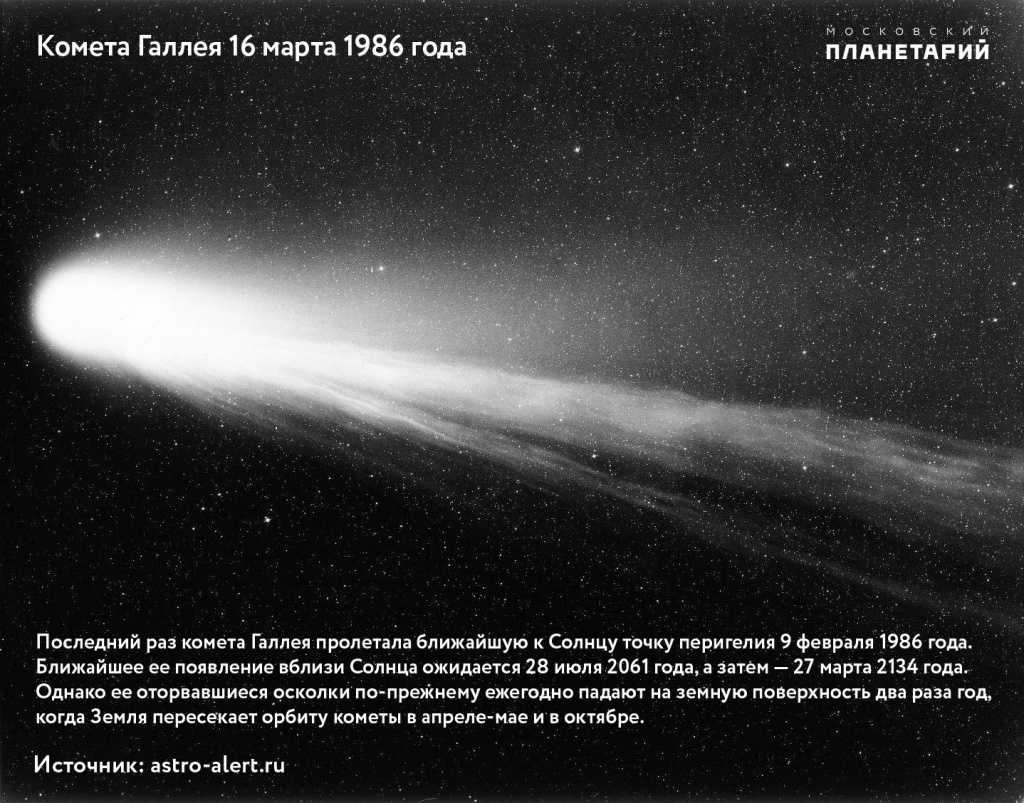
The comet makes its way back to the Sun every 76 years, making a notable appearance in the night sky of our planet. Its most recent encounter with the Sun occurred in 1986, during which it left a trail of cometary dust particles in its orbit. It won’t come close to the Sun and Earth again until July 2061.
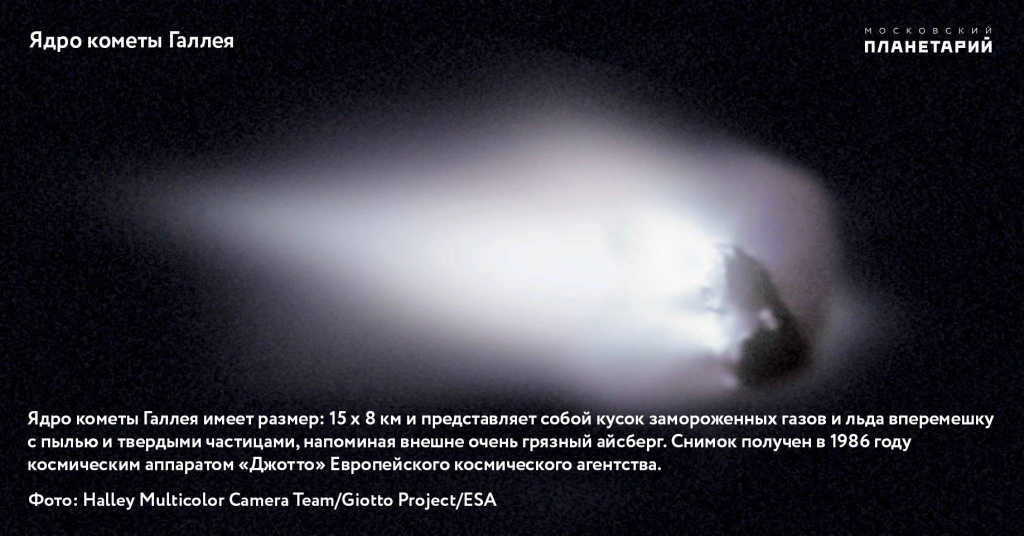

Twice a year, the Earth’s orbit intersects with the orbit of Halley’s Comet, causing the comet’s dust particles to enter the Earth’s atmosphere. This phenomenon creates two meteor streams: the May Aquarids in the spring and the Orionids in the fall.
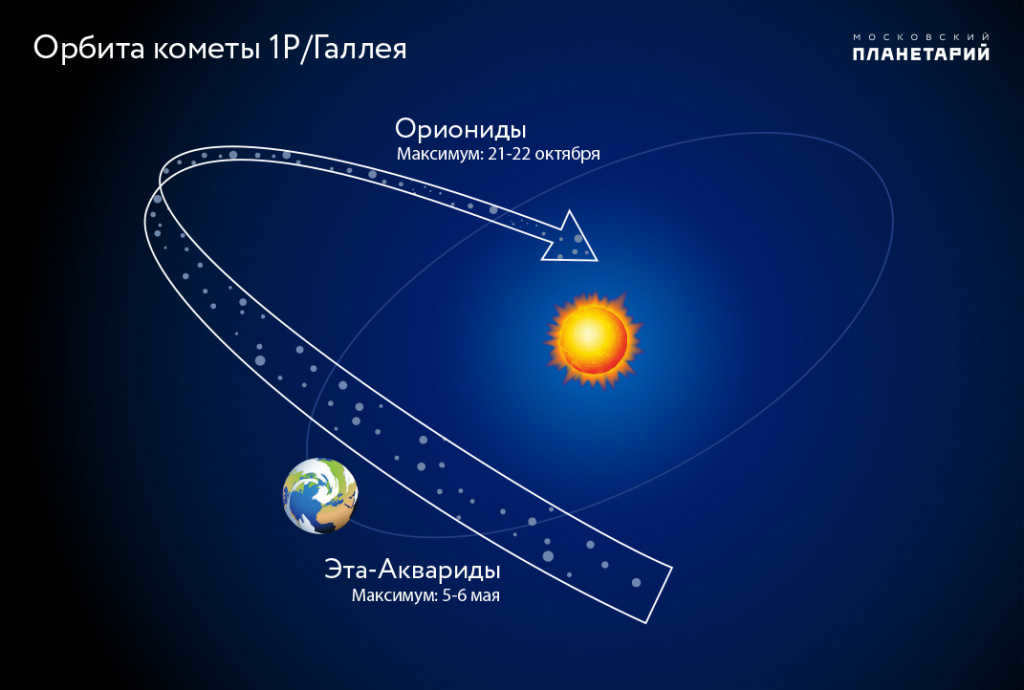
Orionid meteors
The Earth’s atmosphere is frequently bombarded by particles from the Orionid meteor swarm, which travel at an impressive speed of approximately 66 km/sec. These meteors are known for their remarkable velocity and are often accompanied by luminous trails. While most Orionid meteors display a white hue, there are instances where they exhibit shades of red, blue-green, yellow, and orange, all of which can reach a brightness equivalent to +2.5m on the stellar magnitude scale.
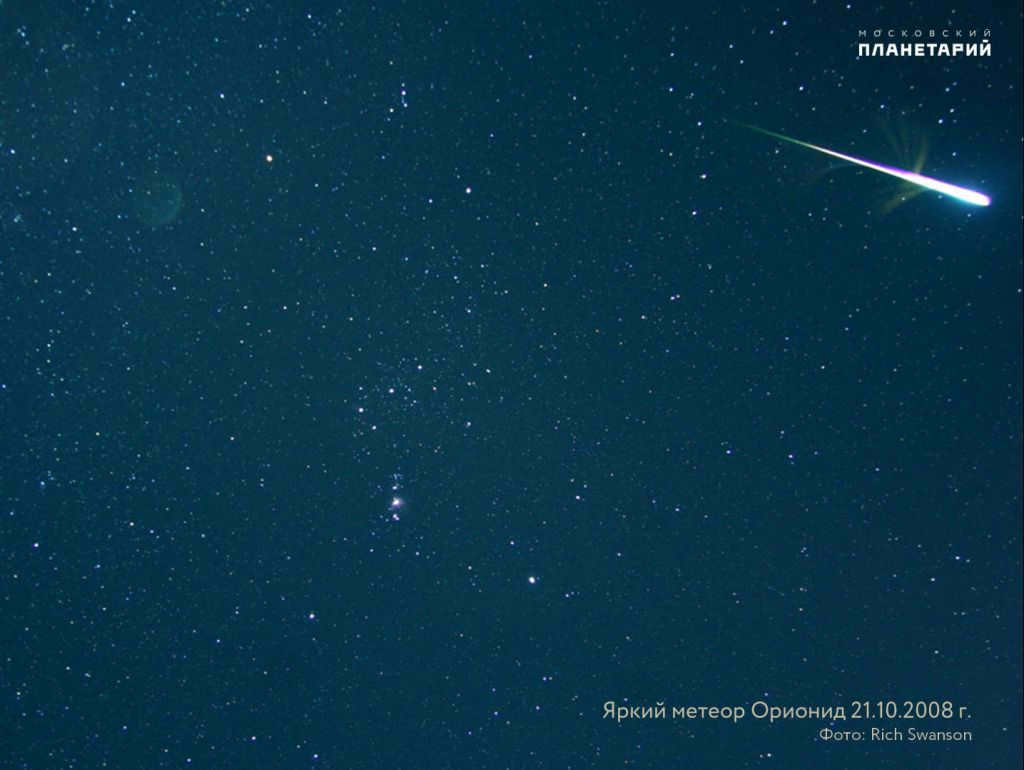
Location of Orionid Radiant
The Orionids meteor shower gets its name from the constellation Orion, where its radiant is situated – the spot from which the meteors appear to originate for observers on Earth.
The first observations of the Orionids were made by Edward C. Herrick, who witnessed the meteor shower in October 1839 and 1840. Alexander Stuart Herschel, the son of John Herschel, successfully predicted its next occurrence. In October 1864, he counted 14 meteors with a radiant in the Orion constellation. Herschel Jr. confirmed the location of the radiant the following year.

The radiant of the Orionids can be seen positioned above and to the left of Betelgeuse, which is the brightest star in the constellation Orion. The optimal period for observing the Orionids in regions with moderate latitudes is from midnight to dawn, when the constellation Orion reaches a sufficient altitude above the horizon.
Observing the Orionid meteor shower in October 2022
Clear weather conditions are ideal for observing the Orionid meteor shower, which can be seen from local midnight to dawn over the southeastern horizon. The peak activity of the Orionids is expected on the night of October 20-21, with the International Meteor Organization forecasting around 20 meteors per hour.
Favorable observing conditions for the Orionids in 2022.
In 2022, the Orionid meteor shower will reach its peak on the night of October 20-21. The moon will be close to the new moon phase on October 25, 2022, meaning its light will not interfere with meteor observations.
We hope you have clear weather and enjoy observing the Orionid meteor shower!
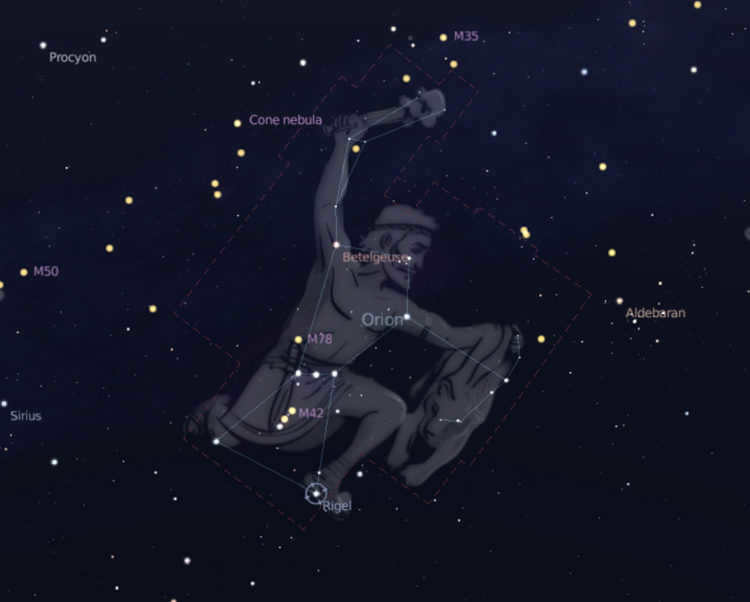
According to Greek mythology, the constellation of Orion in ancient Greece represented the renowned hunter Orion, who was believed to be the son of Poseidon and Euryale. After Orion’s demise from the arrows of the goddess Artemis (or, as another version of the myth goes, from the sting of Scorpio), his father Poseidon placed him in the sky as a constellation.
In ancient Russia, the constellation was referred to as Kruzhiliya or Kolo. In Armenia, on the other hand, the constellation of Orion is known as Hayk, in honor of the patriarch and ancestor of the Armenians. According to traditional beliefs, Hayk’s soul ascended to the sky and transformed into the constellation bearing his name.
In the Inca civilization, the constellation known as Chakra was equivalent to Orion’s belt in the Chimu kingdom, which was a part of the Inca Empire and was referred to as Pata, meaning “Captured”. This name originated from the belief that the moon had sent the two outermost stars to apprehend the middle star as a thief and criminal, subsequently handing it over to the “Vultures”, which are represented by the four stars below and above in the constellation.Captured.”
On a ceramic vessel from the Vucedolian culture discovered near Vinkovci, a town in Croatia, (3000-2600 BC), various constellations, including Orion, the Sun, Cassiopeia, Swan, Gemini, Pegasus, and the Pleiades, are depicted.
The legend of Orion’s constellation
In ancient mythology, there exists a tale of the remarkable hunter known as Orion. This extraordinary individual possessed a slender and graceful physique, enabling him to move with unparalleled agility. Accompanied by his loyal canine companions, Big Dog and Little Dog, Orion embarked on numerous hunting expeditions through the vast forests and towering mountains, seeking out wild beasts. Despite his fierce pursuits, Orion’s heart remained compassionate and gentle.
During one fateful hunt, Big Dog gave chase to a swift hare, causing it to scurry towards Orion’s feet. In a display of unwavering loyalty, the dog cowered and sought refuge with Orion, who promptly shielded him from harm.
Equipped with a formidable staff and a razor-sharp sword, Orion inexplicably found himself in pursuit of elusive plaids. However, his unexpected endeavor was soon interrupted by a furious bull, hurtling towards him with relentless aggression. Unfazed by the imminent danger, Orion defiantly raised his right arm, brandishing his mighty weapon. As the bull lunged forward, Orion delivered a powerful blow to its head, vanquishing the formidable creature.
Thus, he traversed the rugged terrain of the mountains and the thick foliage of the forests, seeking out prey for sustenance. Eventually, his journey led him to the picturesque island of Chios, where an unfortunate encounter with a scorpion resulted in his untimely demise. However, news of Orion’s tragic end reached the ears of Aesculapus, a renowned healer capable of resurrecting the deceased. Determined to bring Orion back to life, Aesculapus arrived on the island of Chios, ready to perform his miraculous act once again. This act did not go unnoticed by Hades, the ruler of the underworld, who grew alarmed at the prospect of losing the spirits of the dead to Aesculapus. In a bid to preserve his dominion, Hades lodged a complaint with his brother Zeus, the mighty Thunderer. Reacting swiftly, Zeus unleashed a powerful bolt of lightning, striking down Aesculapus and putting an end to his life.
Product Description
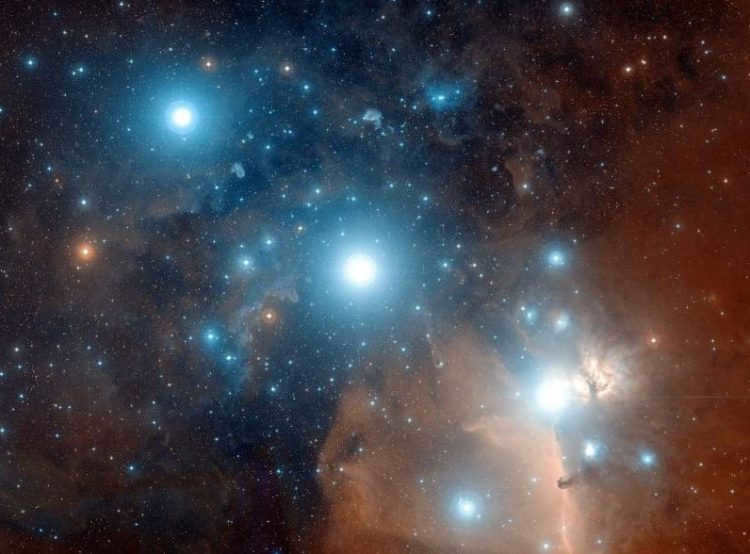
The Orion constellation is home to a multitude of hot stars belonging to the early spectral classes O and B. These stars come together to form a stellar association within the constellation. Additionally, the constellation of Orion is known for its abundance of Orion variables. Among these are the Taurus-type variables, which are grouped into three T-associations within Orion, as well as fuors, with Orion’s FU serving as the prototype.
Constellations and their configurations
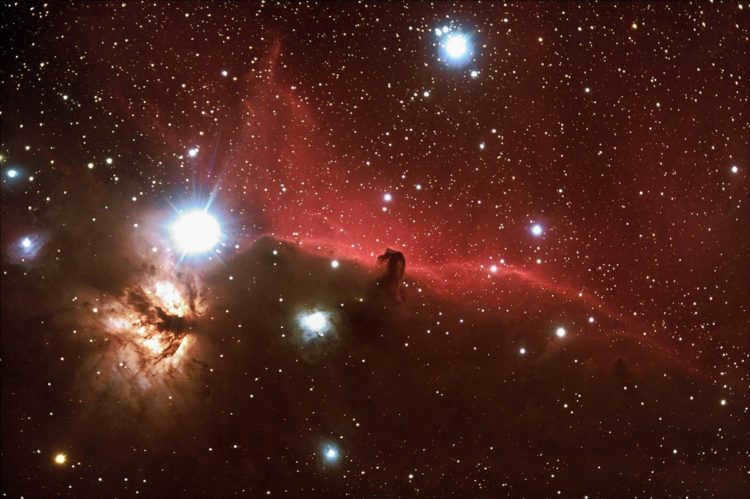
The constellation Orion is characterized by an asterism called the Sheaf, which is made up of several stars including α (Betelgeuse), β (Rigel), γ (Bellatrix), ζ (Alnitak), η (Mintaka), and κ (Saif). Another name for this asterism is the Butterfly.
There are four asterisms that are associated with different parts of the traditional figure of Orion:
- Orion’s Belt is made up of the stars Mintaka, Alnilam, and Alnitak (also known as Orion’s δ, ε, and ζ, respectively). It is also referred to as the Three Kings, the Three Magi, and the Rake.
- The Sword of Orion consists of two stars (θ and ι) and the Great Orion Nebula.
- Orion’s Shield is an asterism made up of six stars arranged in an arc: π1, π2, π3, π4, π5, and π6. It is also known as the Turtle Shell.
- The stars in the following two asterisms are actually the same: Mirror of Venus. The Orion’s Belt asterism, which includes the star that acts as the handle of the Sword and the star η of Orion, forms a diamond-shaped mirror. The Sword of Orion asterism itself serves as the mirror’s handle. Therefore, the asterism consists of the stars η, δ, ε, ζ, θ, and ι of Orion.
- A new asterism called the Saucepan Asterism has emerged among astronomy enthusiasts in Australia. In the southern hemisphere of Earth, celestial objects, including constellations, are visible in an inverted position compared to their visibility in the northern hemisphere. As a result, the Mirror of Venus asterism appears inverted: its handle acts as the handle of a Pot, and the remaining stars form the Pot itself. This asterism also includes the stars η, δ, ε, ζ, θ, and ι of Orion.
The primary celestial bodies in the Orion constellation include
Rigel
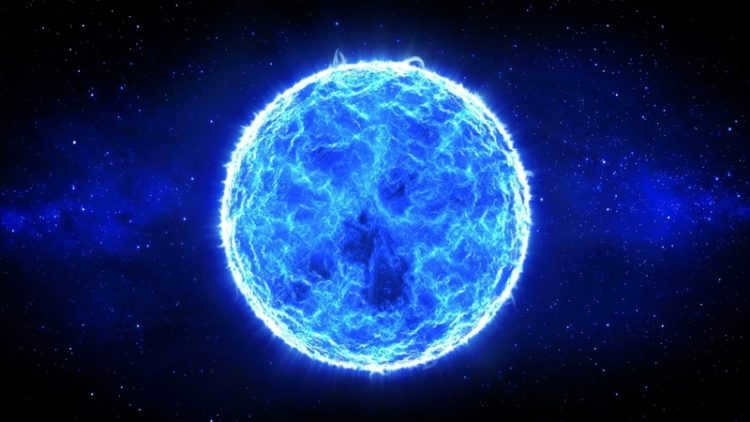
Rigel, also known as Beta Orionis, is a massive blue supergiant star located approximately 772.51 light-years away. It outshines the Sun by a staggering factor of 85,000 and has a mass equivalent to 17 times that of our Sun. Rigel is classified as a variable star, meaning its brightness fluctuates irregularly. Its magnitude can vary from 0.03 to 0.3 over a period of 22-25 days.
With an apparent visual magnitude of 0.18, Rigel is the brightest star in the constellation Orion and the sixth brightest star in the entire night sky. Rigel is actually a triple star system, consisting of three separate objects. In 1831, astronomer F.G. Struve observed Rigel as a visual binary star surrounded by a gas shell.
Rigel A is the dominant component of the system and is approximately 500 times brighter than Rigel B. Rigel B itself is a spectroscopic double star with a magnitude of 6.7. It is composed of two main-sequence stars, both classified as B9V, and they orbit each other with a period of 9.8 days.
The nearby dust clouds that the star illuminates include IC 2118, also known as the Witch’s Head Nebula. This faint reflecting nebula can be found 2.5 degrees northwest of Rigel in the constellation Eridanus.
IC 2118 is part of the Taurus-Orion R1 association. Some experts argue that it would be a perfect fit for Orion’s OB1 Association, but its proximity to us prevents it from joining. The star is approximately 10 million years old and will eventually evolve into a red supergiant resembling Betelgeuse.
The name Rigel comes from the Arabic phrase Riǧl Ǧawza al-Yusra, which means “left foot.” This star marks the left foot of Orion. In Arabic, it is also known as il al-Shabbar, meaning “the foot of the great one.”
Betelgeuse
Rephrase the text, making it unique, using the English language and preserving the HTML markup:
Betelgeuse
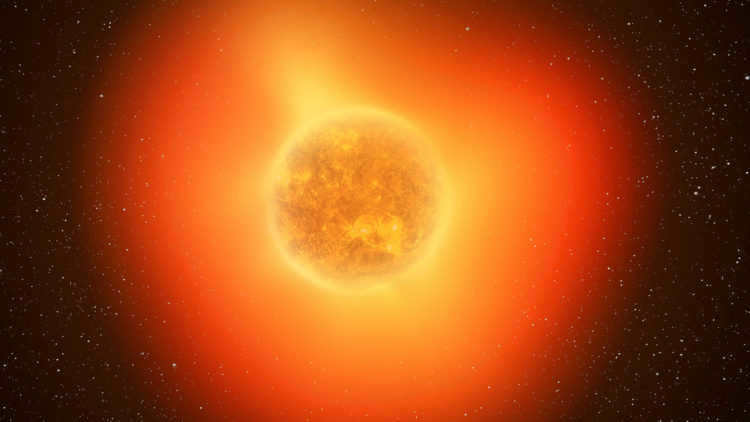
Betelgeuse (Alpha Orionis, 58 Orionis) is a red supergiant (M2lab) with a visual magnitude of 0.42 (the second brightest in the constellation) and a distance of 643 light-years. Its absolute magnitude is -6.05.
Recent findings indicate that the star emits more light than 100,000 suns, making it brighter than the majority of stars in its class. Thus, it can be concluded that the classification is outdated.
The star’s apparent diameter ranges from 0.043 to 0.056 arc seconds. It is challenging to provide a more precise measurement due to the star’s periodic shape changes caused by its significant mass loss.
It forms part of two asterisms: the Winter Triangle (together with Sirius and Procyon) and the Winter Hexagon (Aldebaran, Capella, Pollux, Castor, Sirius, and Procyon).
The term “Betelgeuse” is a corruption of the Arabic phrase “Yad al-Jawzah” – “the hands of Orion”, which was transformed into “Betleguez” in medieval Latin translation. And due to a mistaken interpretation of the first Arabic letter as b, the name “Bait al-Jauzā'” – “Orion’s house” emerged during the Renaissance. It turns out that a single error gave rise to the present-day designation of the star.
Bellatrix
Bellatrix is a star in the constellation Orion. It is also known as Gamma Orionis and is one of the brightest stars in the night sky. Bellatrix is approximately 240 light-years away from Earth and has a mass about 8.6 times that of the Sun. The star is a blue giant, meaning it is much hotter and larger than the Sun. Bellatrix is also a variable star, which means its brightness fluctuates over time. It is a fascinating celestial object that has captivated astronomers and stargazers for centuries.
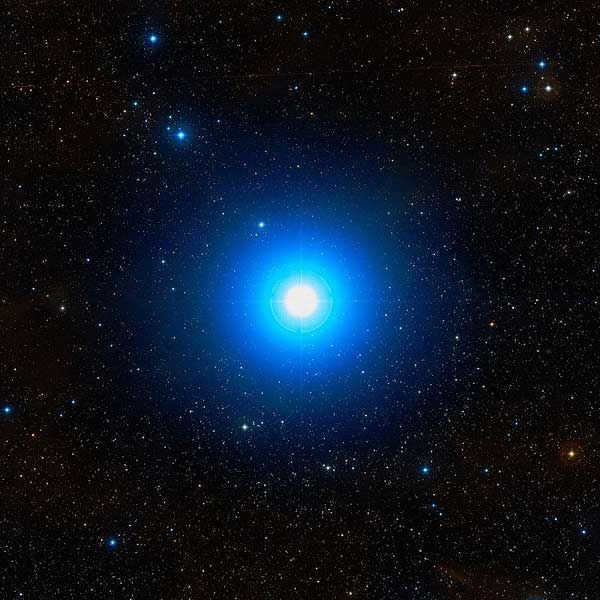
Bellatrix (Orion Gamma, 24 Orion) is a massive, luminous blue-white giant (B2 III) with a fluctuating apparent magnitude ranging from 1.59 to 1.64 and located about 240 light-years away. It is one of the most scorching stars that can be seen without the aid of a telescope. It emits 6400 times more sunlight than our Sun and possesses a mass equivalent to 8-9 times that of our Sun. In a few million years, it will transition into an orange giant before eventually evolving into a massive white dwarf.
Occasionally referred to as the Amazon Star, Bellatrix is the third brightest star in the Orion constellation and the 27th brightest star in the entire night sky. Its name is derived from the Latin term for “warrior woman.”
Mintaka
Mintaka, also known as Orion Delta, is a binary variable star system. The primary star in this system is a B-type giant, while the secondary star is a hot O-type star. These two stars orbit each other every 5.63 days and periodically eclipse each other, causing their combined brightness to decrease by 0.2 magnitudes. In close proximity, there is another star with a magnitude of 7, as well as a fainter star with a magnitude of 14.
This stellar system is located approximately 900 light years away from Earth. The primary and secondary stars are incredibly luminous, being 90000 times brighter than the Sun and possessing more than 20 times its mass. Eventually, both stars will reach the end of their lives and undergo supernova explosions. In terms of apparent brightness, the magnitudes of the components are as follows: 2.23 (3.2/3.3), 6.85, and 14.0. The name “Mintaka” is derived from the Arabic word “manţaqah,” which means “region.” Mintaka is the faintest star in Orion’s belt and the seventh brightest star in the constellation.
Alnilam
can be restated as
The Brightest Star in Orion’s Belt
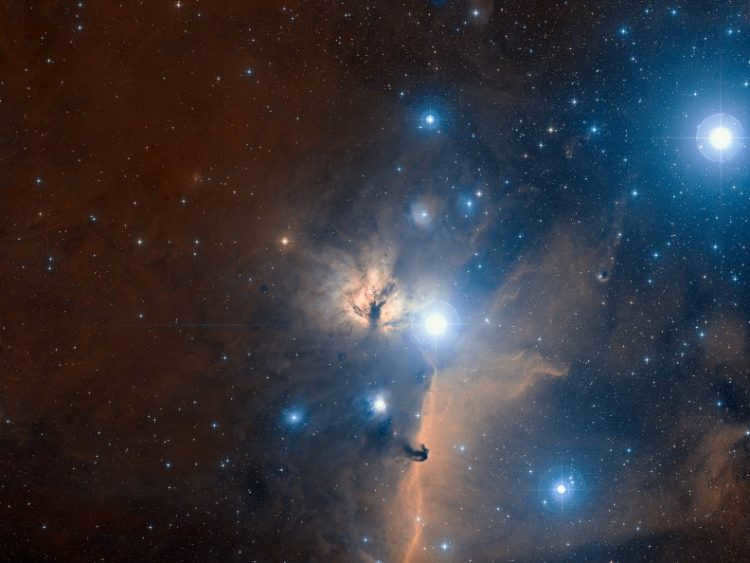
Alnilam (also known as Orion Epsilon or 46 Orion) is a supergiant star with a hot, bright blue color (spectral type B0). It has an apparent magnitude of 1.70 and is located approximately 1,300 light-years away. Within the constellation of Orion, Alnilam is the fourth brightest star and the thirtieth brightest star in the entire sky. It holds a central position within the famous Orion’s Belt. Alnilam emits an astonishing 375,000 times more light than our own Sun.
Surrounding Alnilam is the NGC 1990 nebula, which is a molecular cloud. The stellar wind produced by Alnilam reaches speeds of up to 2,000 kilometers per second. This star is relatively young at around 4 million years old. However, it is currently losing mass, indicating that its internal hydrogen fusion is nearing its end. In the near future, Alnilam will transform into a red supergiant, becoming even brighter than Betelgeuse, another famous star in Orion, and ultimately explode as a supernova. The name Alnilam originates from the Arabic word “an-niżām,” meaning “string of pearls.”
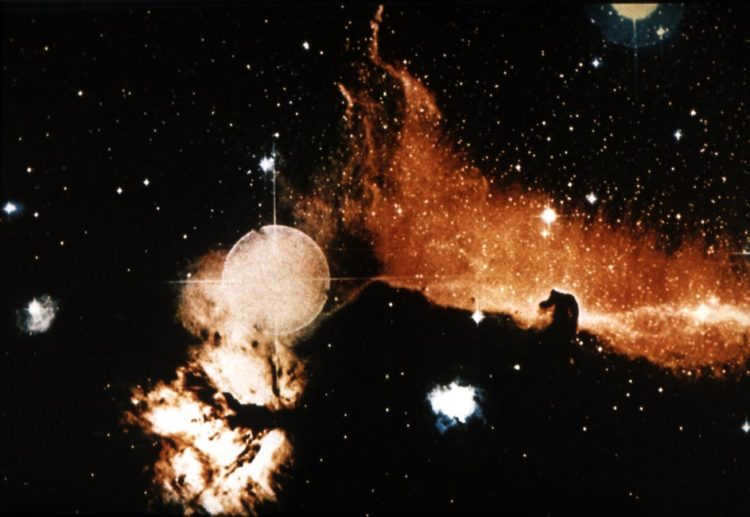
Alnitak (also known as Zeta Orionis or 50 Orionis) is a system of stars that can be seen with an apparent magnitude of 1.72 and is located at a distance of 700 light-years. The most prominent star in this system is Alnitak A, which is classified as a hot, blue supergiant (O9) and has an absolute magnitude of -5.25 and a visual magnitude of 2.04.
This star system is a close binary, consisting of a supergiant (O9.7) with a mass 28 times that of the Sun, and a smaller blue dwarf star (OV) with an apparent magnitude of 4 (which was discovered in 1998). The name “Alnitak” is derived from the Arabic word for “belt”. On February 1, 1786, the nebula associated with Alnitak was discovered by William Herschel. Alnitak is the easternmost star in the famous constellation Orion’s Belt and is located in close proximity to the emission nebula IC 434.
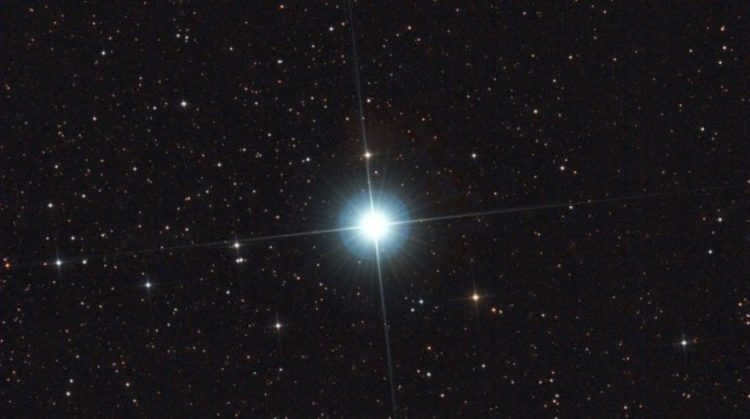
Saif (Kappa Orionis or 53 Orionis) is a blue supergiant star (B0.5) that has an apparent visual magnitude of 2.06 and is located at a distance of 720 light-years. It is the 6th brightest star in the constellation Orion. Saif is positioned in the southeastern part of the Orion quadrangle.
The star’s name, Saif, is derived from the Arabic phrase “saif al jabbar,” which means “sword of the giant.” Like many other luminous stars in the Orion constellation, Saif is expected to eventually undergo a supernova explosion.
Nair Al Saif
can be paraphrased as
Nair Al Saif
is an alternative way to express the same name.
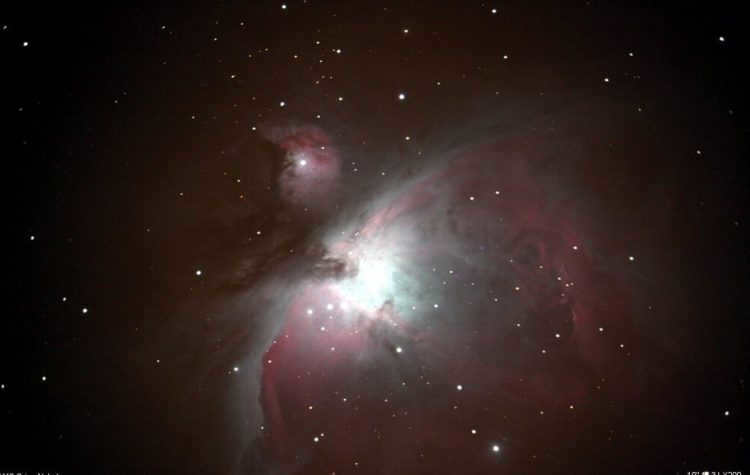
Nair Al Saif (Iota of Orion) is the brightest star in Orion’s sword and the fourth star system in the constellation. It has an apparent magnitude of 2.77 and is located approximately 1,300 light years away. The Arabic name Na’ir al Saif translates to “bright sword.”
At the center of this star system is a massive spectroscopic double star with a 29-day orbit. The system consists of a blue giant (O9 III) and a star (B1 III). Due to the constant collision of stellar winds between the two stars, Nair Al Saif emits a significant amount of X-ray radiation.
Lambda Orion
Let’s rephrase the text, making it unique, using the English language and preserving the HTML markup:
Lambda Orion
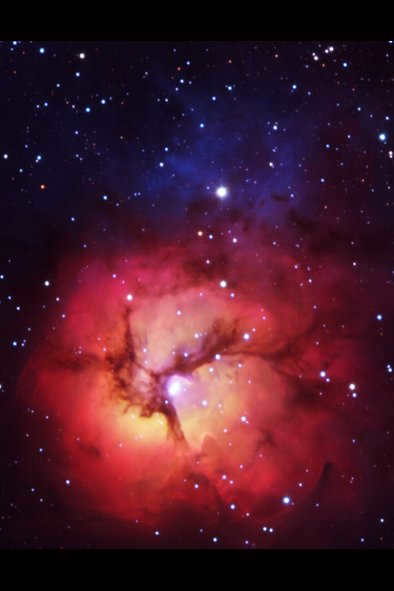
Lambda in the Orion constellation is a massive blue star (O8III) that shines with a visual magnitude of 3.39 and is situated 1100 light years away. This star system is made up of two stars. The companion star is a scorching blue-white dwarf (B0.5V) that appears with a magnitude of 5.61. It can be found at a distance of 4.4 arc seconds from the main star.
Meissa, the traditional name given to Lambda, has its roots in Arabic and means “shining”. This star is sometimes referred to as Heka, which means “white spot”.
Phi Orion
Phi Orion is the name given to a pair of star systems that are located 0.71 degrees apart from each other. Phi 1, the first star system, is a binary star system that is situated 1000 light years away. The primary star in this system is a main-sequence star of spectral type B0 and has an apparent magnitude of 4.39. On the other hand, Phi 2 is a giant star of spectral type K0, located at a distance of 115 light years, and has an apparent visual magnitude of 4.09.
Orion’s Pi is a group of stars that form the shield of Orion. Unlike most binary and multiple stars, the objects in this system are widely spaced apart. Pi-1 and Pi-6 have a separation of nearly 9 degrees.
- Pi-1 (7 Orion) is the least bright star in the system. It is a main-sequence white dwarf (A0) with a visible magnitude of 4.60 and a distance of 120 light-years.
- Pi-2 (2 Orion) is a main-sequence dwarf (A1Vn) with a visual magnitude of 4.35 and a distance of 194 light-years.
- Pi-3 (1 Orion, Tabit) is a white dwarf (F6V) located 26.32 light-years away. It is the brightest of the six stars, with a mass of 1.2 solar masses, a radius of 1.3, and a brightness that is three times greater. It is believed to have Earth-sized planets. The Arabic name al-Tabit means “patience.”
- Pi-4 (3 Orion) is a binary star system located approximately 1,250 light-years away. This system consists of a giant and a subgiant, both classified as B2 stars. Their close proximity makes them appear as a single star even when observed through a telescope. However, their distinct spectra reveal their binary nature. The two stars orbit around each other with a period of 9.5191 days. They have a combined mass that is 10 times greater than that of the Sun and a luminosity that is 16,200 and 10,800 times brighter.
- Pi-5 (8 Orion) is a single star situated about 1,342 light-years from us. It has an apparent magnitude of 3.70.
- Pi 6 (10 Orion) is a vibrant orange giant star classified as K2II. This variable star has an average visual magnitude of 4.45 and is located approximately 954 light-years away.
This Orion
Eta Orionis is a binary star system consisting of two blue stars (B0.5V) that undergo eclipses. This system is situated approximately 900 light-years away from us. It exhibits a variation in brightness known as a Beta Lyrae variable, which is caused by one star passing in front of the other. The visual magnitude of Eta Orionis is measured to be 3.38. It is found in the Orion arm, which is a minor spiral arm of our Milky Way galaxy. Specifically, it can be located to the west of Orion’s Belt.
Orion’s Sigma
Orion’s Sigma is a celestial system comprising of 5 stars situated to the south of Alnitak. The system is positioned at a distance of 1150 light-years.
The primary entity within this system is the binary star Sigma Orion AB, which consists of two hydrogen-fusing dwarfs separated by a distance of 0.25 arc seconds. The brighter component is a blue star (O9V) with a visual magnitude of 4.2. The companion is a star (B0.5V) with a visual magnitude of 5.1. It takes them approximately 170 years to complete a full orbit around each other.
Sigma C is a dwarf star (A2V) with a visual magnitude of 8.79. Sigma D and E are both dwarf stars (B2V) with visual magnitudes of 6.62 and 6.66, respectively. E is notably distinguished by its significant abundance of helium.
V380 Orion
Rewrite the text, making it unique, using the English language and preserving the HTML markup:
V380 Orion
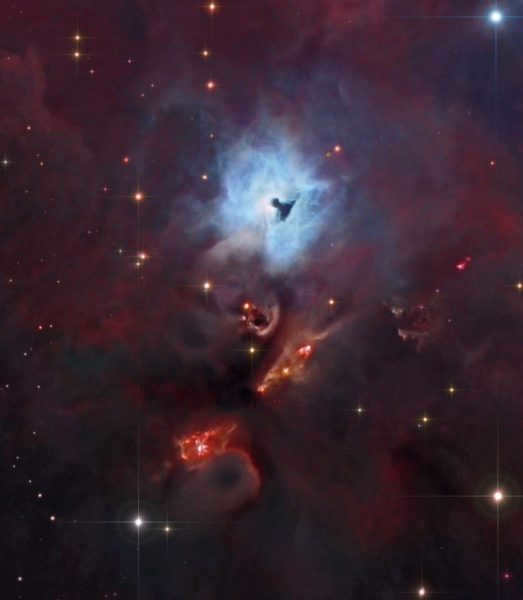
The triple star system V380 in the constellation Orion is responsible for illuminating the reflected nebula NGC 1999. It belongs to the spectral type A0 and is located at a distance of 1000 light years.
Within the nebula, there is a large empty hole that appears as a black spot in the center. The reason for its darkness is still unknown, but there is speculation that narrow jets of gas from nearby young stars may have penetrated the dusty and gaseous layers of the nebula. Additionally, the strong radiation emitted by an older star in the region may have contributed to the formation of the hole. The nebula itself is positioned 1,500 light-years away.
GJ 3379 is a red dwarf of spectral type M3.5V, with a visual magnitude of 11.33 and a distance of 17.5 light years from Earth. It is estimated to have been located 4.3 light years away from the Sun approximately 163,000 years ago. This star is the closest one to our solar system in the Orion constellation, which is situated only 17.5 light years away.
Astronomical entities in the Orion constellation
The Magnificent Orion Nebula
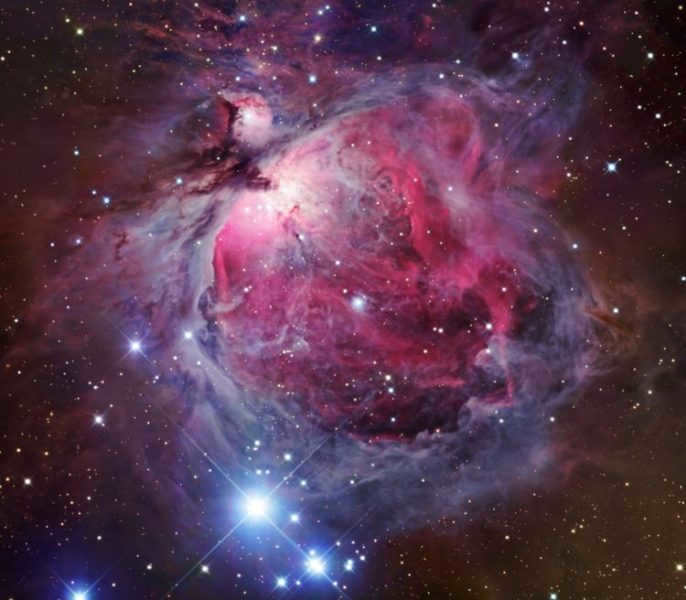
Johannes Cisat, a German astronomer, was the first to observe the Great Orion Nebula in 1618. It is also known as M 42 (Messier 42). Situated below Orion’s Belt, this emission nebula emits a greenish glow. When viewed through binoculars, the nebula appears as a blurred, radiant spot with an undefined shape.
The density of this gaseous or diffuse nebula is approximately 1017 times lower than the density of the air in a room. It is known as the brightest diffuse nebula and covers an area of about 80 x 60 angular minutes, which is more than four times the size of the full Moon. As a result, it is easily visible to the naked eye in the night sky, and its location on the celestial equator means that it can be seen from almost anywhere on Earth. The nebula is located approximately 1,600 light-years away from Earth and has a diameter of 33 light-years.
The Orion Nebula is highly luminous, but the light it emits is considered “cold” and is primarily caused by luminescent processes near or within the nebula. These processes are mainly driven by hot stars.
In the northern part of the nebula, there is a dark band of dust that separates its northeastern section (known as M43) from the main part of the nebula.
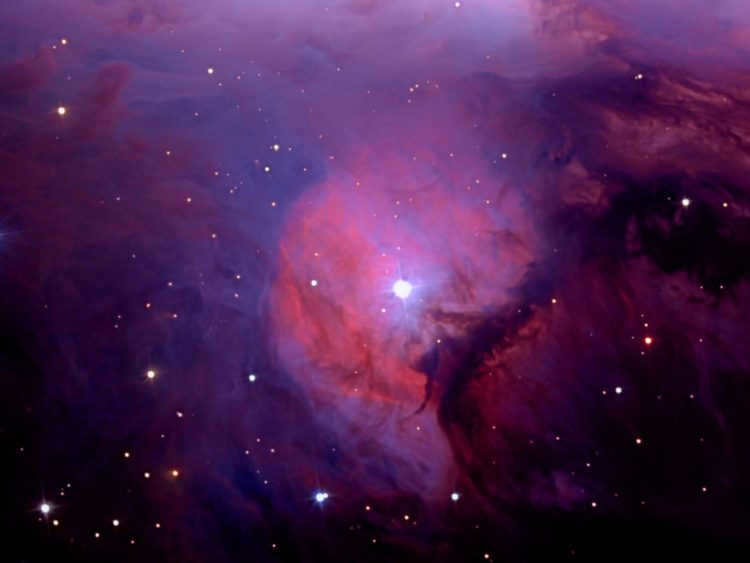
M43, also known as Messier 43, can be found in the constellation Orion. This emission nebula is a prime location for active star formation and is characterized by its ionized hydrogen. When observed through a telescope, M43 appears as a comma shape, situated near the renowned Orion Nebula.
Orion’s θ, located in the middle of Orion’s Sword, is a well-known multiple star system. Composed of four bright components, it forms a small quadrilateral known as Orion’s Trapezium. This star system is situated within a diffuse star cluster at the center of the Great Orion Nebula, the very nebula from which it originated. Additionally, there are four other fainter stars within the system. All of these stars are incredibly young, having recently formed from interstellar gas within an invisible cloud that spans the entire eastern region of the Orion constellation. Only a small portion of this cloud, which has been heated by the young stars, is visible under Orion’s Belt. When observed through a small telescope or even binoculars, it appears as a greenish cloud and is considered the most captivating feature of the Great Orion Nebula.
In 1780, Pierre Messier discovered a group of highly reflective nebulae known as M78 (Messier 78) in the Orion constellation. These nebulae are situated in the northeastern region of ξ.
Located half a degree northeast of the Orion Nebula is the Running Man, a blue reflecting nebula identified as NGC 1977. The Running Man is comprised of both a nebula and a star cluster.
The well-known Horsehead Nebula is located 0.5° south of the eastern Belt star (ζ Orion) and stands out against the bright background of the nebula. Its distinct shape, resembling a horse’s head, was first documented in 1888 through photographs taken by the Harvard Observatory. The dark dust clouds contrast with the red glowing interstellar gas, creating a striking visual. The red glow is caused by the ionization of hydrogen gas behind the nebula, triggered by radiation from the nearby bright star ζ Orion. The dark background of the nebula is primarily due to light absorption by a dense layer of dust, although there are shaded areas to the left, caused by the base of the Horsehead’s neck. The gas within the nebula moves within a powerful magnetic field. At the base of the Horsehead Nebula, there are bright spots that indicate the presence of young stars in the process of formation. The nebula itself spans approximately 3.5 light-years and is a part of the larger Orion Cloud.
Orion Cloud
can be rephrased as
Orion Cloud Services
.
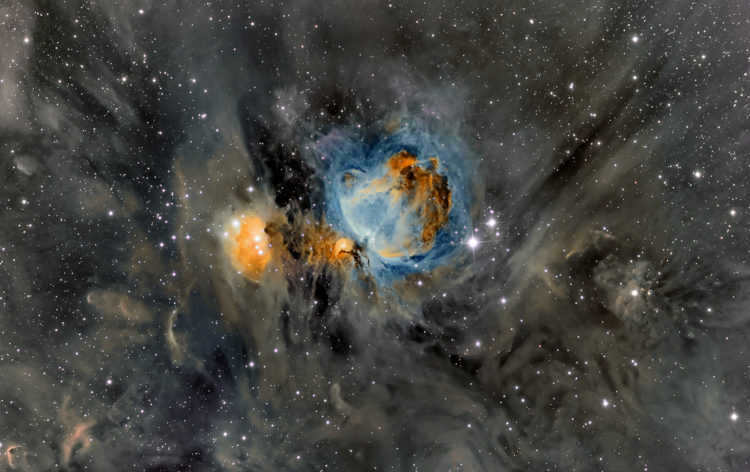
Located in the constellation Orion, the Orion Cloud is a cluster of interstellar matter, also known as a nebula. This nebula is situated within the Milky Way galaxy, approximately 1600 light-years away, and spans a size of a few hundred light-years.
Spanning a vast region, the Orion Cloud is home to numerous known objects of various types. These objects contain the substance of the cloud and can be observed using binoculars or amateur telescopes. Some notable objects within this region include the Orion Nebula (M42), M78, M43, Horsehead Nebula, Barnard’s Loop, Flame Nebula, the complex of reflective nebulae known as the Running Man, and others.
- The Flame Nebula, officially known as NGC 2024, is an emission nebula located near the Horsehead Nebula.
- The Witch’s Head, designated as IC 2118, is a nebula formed by supernova remnants illuminated by the nearby Rigel star.
- Barnard’s Loop spans a wide semicircle, covering the majority of its eastern and southern side as well as a significant portion of the Orion constellation. This loop is the result of a series of supernova explosions. The Orion molecular cloud is currently experiencing active star formation, resulting in the presence of numerous young stars. The most massive of these stars quickly progress through their life stages and eventually explode as supernovae, leaving their birthplace behind. However, there are also young hot stars that have not yet reached the end of their lifecycle and continue to illuminate Barnard’s Loop.
- Another notable feature in the Orion constellation is the Italy Nebula (NGC 2024), also known as the Flame Nebula. It is a complex formation consisting of an emission nebula and a dark nebula.
Amateur astronomers are now able to contribute to scientific discoveries. For instance, on January 23, 2004, Jay McNeil, an astronomy enthusiast from Kentucky, directed his 3″ telescope towards the Orion constellation to capture images of the M78 nebula’s surroundings. To his astonishment, while analyzing the resulting image, he detected a previously unidentified and radiant nebula. This nebula has since been designated as the McNeil Nebula. Positioned on the outskirts of this nebula is a prominent star that provides its illumination.
What is the method of locating the Orion constellation?
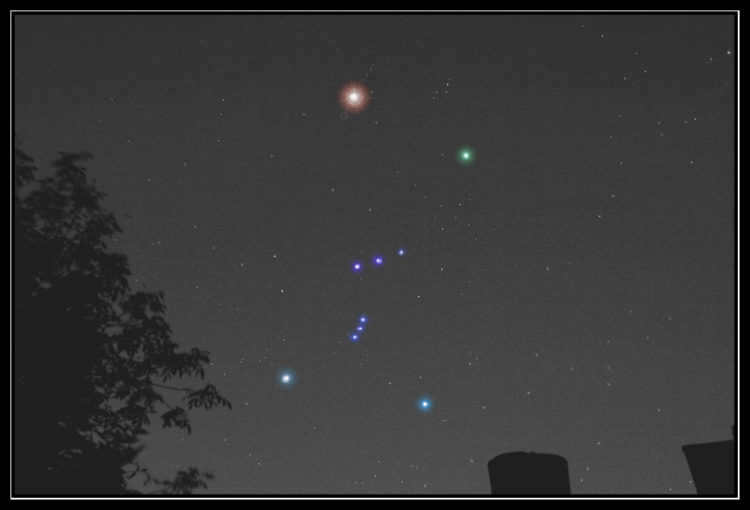
In the middle latitudes of the northern hemisphere, the constellation Orion can be observed during the late summer months (starting in mid-August), as well as throughout the fall, winter, and the first half of spring (until mid-April). The most favorable conditions for observing Orion occur between November and January, when the constellation can be seen from sunrise to sunset. This celestial formation can be spotted all across Russia and is classified as an autumn-winter constellation. Specifically, in September, Orion rises in the early morning and remains visible for a period of 2 hours before sunrise. In October, the constellation rises at night, and in November, it can be observed in the late evening.
If you mentally connect the stars of the Orion’s belt with a line and extend it downwards, it leads to Sirius, which is the most luminous star in the entire nocturnal sky and the primary star of the Canis Major constellation. During September, Sirius ascends approximately 1.5 to 2 hours prior to daybreak in the southeastern direction. Due to its relatively low placement above the horizon, the star has the ability to twinkle and glisten in various hues, resembling a precious gem in the presence of a radiant beam.
Video
can be paraphrased as
Visual Content
,
Moving Images
, or
Motion Pictures
.
The summer season offers a stunningly beautiful display of the starry sky. During warm, clear nights, one can witness an astonishing number of lights shining overhead. However, there are specific celestial formations that are most notable during the colder months. Among these is the well-known constellation Orion, which consists of 209 stars visible to the naked eye. Orion stands out due to its abundance of bright cosmic objects, making it easily recognizable from our planet. The optimal period for observing these celestial wonders is from November to January.
Recognized globally
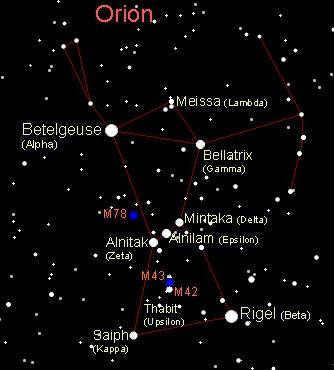
Most people on Earth are familiar with the appearance of the Orion constellation, as it can be seen in both the northern and southern hemispheres. The stars in Orion are positioned along the celestial equator, making them easily visible.
This article provides information about the well-known Orion’s Belt constellation, including its description and the legend that inspired its name.
In winter evenings in the southern part of the sky, the constellation Orion is particularly prominent in the Northern Hemisphere. At this moment, the three stars that make up Orion’s belt form a nearly straight line close to the horizon, at a slight angle to it. A total of eight bright stars create a distinct outline. Since ancient times, this celestial figure has been connected to the image of Orion the hunter, who is depicted with a sword hanging from his belt, a club in one hand, and a shield in the other.
Mythology
The story of the constellation Orion is not typically learned in astronomy classes, but rather through the exploration of ancient Greek mythology. According to the legends, Orion was a skilled hunter who fell in love with the beautiful Pleiades, nymphs who served the goddess Artemis. Despite his attempts to approach them, the nymphs were frightened and called upon Artemis for help. In response, Artemis transformed the seven Pleiades into doves, and they ascended into the heavens, where they became a constellation.
When looking up at the night sky, it is easy to locate the constellation Orion by finding its two prominent stars, Rigel and Betelgeuse. These stars serve as guideposts for identifying the rest of the constellation.
Demise of a Champion
For an extended period, Orion roamed the earth in solitude, desperately seeking someone capable of restoring his vision. Eventually, he encountered a compassionate Cyclops who took pity on him and guided him to Helios. The mighty sun god possessed the power to grant the hero his sight once more. Without much hesitation, Orion returned to indulging in his beloved pastime. While in the pursuit of his prey, he caught the attention of Artemis, a fellow enthusiast of the hunt. In due course, Orion became her lover, much to the dismay of Apollo, Artemis’ brother. Determined to ruin the hunter through deceit, Apollo, aware of Artemis’ pride, began to question her accuracy in archery. To put her skills to the test, he proposed that she attempt to hit a distant, flickering dark spot in the sea. Unbeknownst to the goddess, that spot was the head of Orion, who had decided to bathe.
Artemis soon learned that she was responsible for the death of her lover. Grieving for Orion, she made a vow to always remember him and placed him among the stars. This is how Orion – the constellation – came to shine in the sky. There are other myths that speak of a different fate for the hero. According to one version, he fought bravely against wild beasts that threatened the people of the island of Chios in the hope of winning the hand of the beautiful Merope. Despite his victory over the beasts, he did not win the girl’s heart and instead was captured and blinded by her father. After encountering Helios, Orion regained his sight, but was eventually killed by the wrathful Artemis, the protector of beasts.
Extremely noticeable
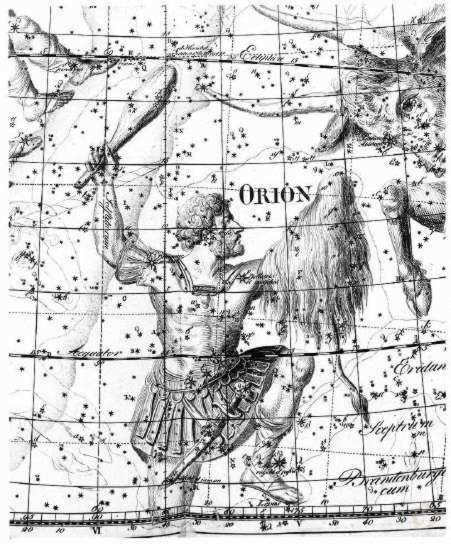
The appearance of the Orion constellation today is the same as it was observed thousands of years ago. This celestial drawing was documented in Claudius Ptolemy’s Almagest catalog around 140 AD. The ancient civilizations were fascinated by Orion due to its prominent elements that can be easily seen from Earth, capturing the attention of curious observers. Even modern scientists are captivated by this celestial pattern and have extensively studied many of the objects within it.
Rigel and Betelgeuse are the two brightest stars within the Orion constellation. By using these two stars as reference points, one can easily locate the complete figure of the hunter in the night sky.
The First Star in Orion
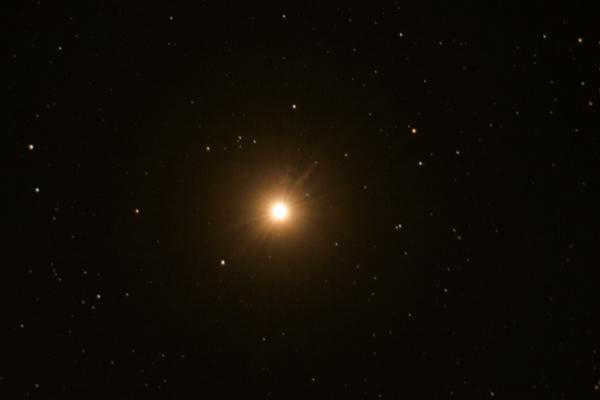
Betelgeuse, which is derived from the Arabic word meaning “armpit,” is an unmistakable name for a star due to its location. This bright celestial body is situated right on the armpit of the constellation Orion. Betelgeuse shines with a brilliance that is fifteen thousand times greater than that of our Sun. In fact, its size is so immense that it surpasses the orbit of Mars. As a red supergiant, Betelgeuse is located approximately 540-650 light years away from our planet. Furthermore, it is categorized as a semi-regular variable star, which means that its visual brightness fluctuates over time. The range of this variation for Betelgeuse spans from 0.4 to 1.3 stellar magnitude, and its primary cycle lasts for a duration of 6 years.
Beta Orion
Rephrase the text, making it unique, using the English language and preserving the HTML markup:
Beta Orion
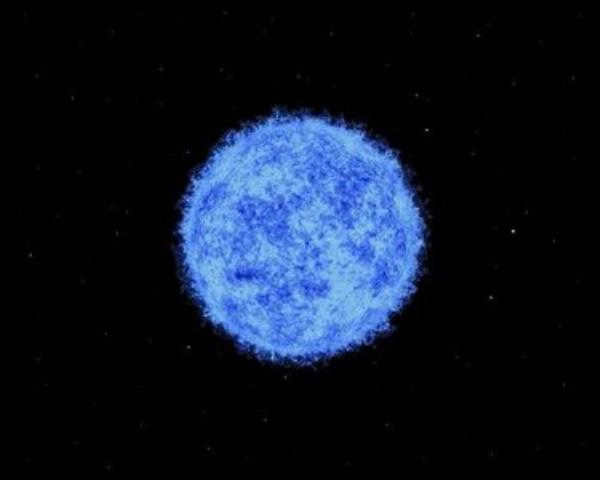
While Betelgeuse is the alpha star in the Orion constellation, it is not the brightest point within the figure. Rigel, which means “foot” in Arabic, surpasses Betelgeuse in terms of brightness. Rigel’s luminosity is about 130,000 times greater than that of the Sun, and it is located at a distance of approximately 700 to 900 light years from Earth. This makes Rigel the closest star to us with such high luminosity. Its visual magnitude is 0.12.
Rigel, a member of a star system, is a blue-white supergiant. Its brightness is considerably greater than that of its companion, Rigel B, which has an estimated apparent stellar magnitude of +6.7. The two components are separated by a distance of about 2200 astronomical units. Rigel B can only be observed through a telescope due to its close proximity to the bright supergiant. Additionally, the star system includes a third component, Rigel C.
Stars like Betelgeuse and Rigel in the Orion constellation have a relatively short lifespan due to their massive size and high luminosity. They are estimated to be around 10 million years old, much younger than the Sun, which is over 4.5 billion years old. These stars will not survive as long as our Sun. The immense mass of these stars creates significant pressure, causing them to burn through their fuel rapidly. Eventually, the core of the star will collapse into a neutron core, causing the outer shells to collide and rebound at an incredible speed. This will result in a type 2 supernova explosion.
Rigel and Betelgeuse are destined for a similar fate. When they explode, the appearance of the famous hunter in the sky, also known as the constellation Orion, will drastically change. The collapse of Rigel will be observable from Earth during both day and night. The star will shrink to a size similar to a quarter of the Moon, gradually dimming until it becomes a tiny dot. Betelgeuse, on the other hand, is predicted to last for at least two thousand years before its explosion. Once it does explode, it will become as large as the Moon. However, this massive size will only be temporary, lasting a few weeks before it also fades away. These extraordinary events, though fascinating to ponder, are far in the future. For now, we can still marvel at the brilliance of the bright stars in the constellation Orion.
Belt
The constellation contains a plethora of asterisms, which are highly visible star clusters with distinct historical names. One of these asterisms is the hunter’s belt, which serves as a recognizable feature of the Orion constellation for both children and adults throughout the year. Comprised of three relatively bright stars, namely Mintaka (delta, derived from the Arabic word for “belt”), Alnitak (zeta, meaning “pearl belt”), and Alnilam (epsilon, signifying “girdle”), this asterism is also referred to as the “Three Kings” or “The Rake”. These three prominent stars align almost perfectly in a straight line and are equidistant from one another. If the southeastern end of this line is extended, it will lead to Sirius, the brightest star in the night sky. Similarly, extending the northwestern end of the line will point towards Aldebaran, the red star in the Taurus constellation.
Sheaf
The distinct shape of the constellation is formed by a group of bright stars known as the Sheaf or Butterfly. It consists of several notable stars: Betelgeuse, Rigel, Bellatrix (gamma), Alnitak, Mintaka, and Saif (kappa).
Gamma Orionis, also known as Bellatrix, is the third most luminous star within this celestial formation. It is classified as a blue-white giant and has an apparent magnitude of 1.64. While the star’s luminosity exceeds that of the Sun by 4,000 times, its mass and radius are not as remarkable. It has a mass of approximately 9 times that of the Sun, and its radius is only 5.7 times larger. Bellatrix is believed to be around the same age as Rigel and Betelgeuse, with an estimated age of 10 million years. Scientists predict that it will eventually evolve into a red giant in a few million years.
The star Saif, which is white-blue in color, is positioned at a similar distance from Earth as Rigel. However, it appears much fainter due to the majority of its energy being emitted in the invisible spectrum. Saif has a luminosity that is 5,500 times greater than that of the Sun, and its diameter is 11 times larger.
The primary weapon
Sword is another well-known group of stars that belongs to the constellation Orion. It consists of two stars, θ and ι (theta and iota), as well as the impressive Great Orion Nebula.
Theta is a system of multiple stars, consisting of four bright components and an equal number of less prominent ones. Together, they form a small quadrilateral known as Orion’s Trapezium. These stars are relatively young cosmic entities that formed from interstellar gas and dust. The material for these celestial bodies originated from an invisible cloud located in the eastern part of the constellation, which is known as the Great Orion Nebula.
“Stellar nursery.”
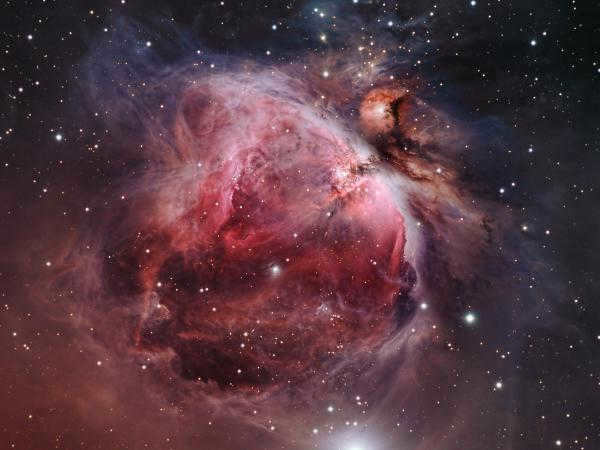
Black Hole
A new addition to the map of the Orion constellation near Trapezium has recently caught the attention of astronomers. Recent studies suggest that the nebula M42 has experienced numerous star collisions during its evolution, potentially resulting in the formation of a black hole that is a hundred times more massive than the Sun. This hypothesis is supported by the high velocities observed in the stars within the Trapezium of Orion. If the presence of a black hole is confirmed, it would be the closest known object of its kind to our solar system.
A horse’s head
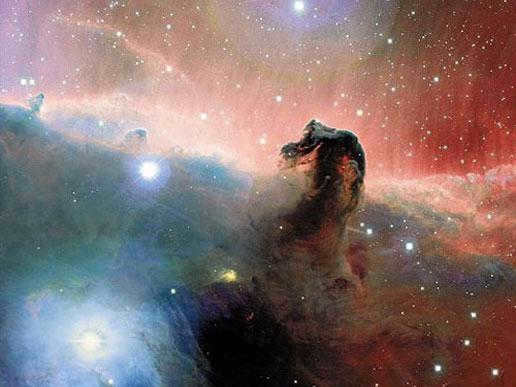
Animal-like shapes can be found not only in the constellations in the sky, but also in other celestial objects. One well-known example is the Horsehead Nebula (or B33) in the Orion constellation, which bears a striking resemblance to a horse’s head. The reason we are able to see such a clear outline of the Horsehead Nebula is because it is illuminated by another nebula that serves as a backdrop. Unlike the illuminated nebula, the Horsehead Nebula itself does not emit light and is considered to be an absorbing nebula. Without the bright background, it would be difficult to observe the Horsehead Nebula. In fact, not every instrument is capable of detecting it under the given conditions. Therefore, the presence of the Horsehead Nebula has become a marker for the functionality and accuracy of astronomical equipment.
Reflection Nebulae in the Orion Constellation
When describing the appearance of the constellation Orion, it would be remiss not to mention several other nebulae that are often overlooked by researchers due to their less pronounced external features. These nebulae are known as reflection nebulae and, while they may not be as visually striking as the prominent M42, they still hold some degree of interest. Situated slightly north of M42 in Orion’s Sword, the nebulae NGC 1977, NGC 1975, and NGC 1973 possess a bluish hue in images due to the reflection of light from young, bright stars by cosmic dust. When captured in telescope photographs, these three nebulae, separated by dark regions that are illuminated by the reddish emission of hydrogen atoms, create the distinct silhouette of a running man – an easily identifiable image within the constellation Orion.
Birthing the Illumination
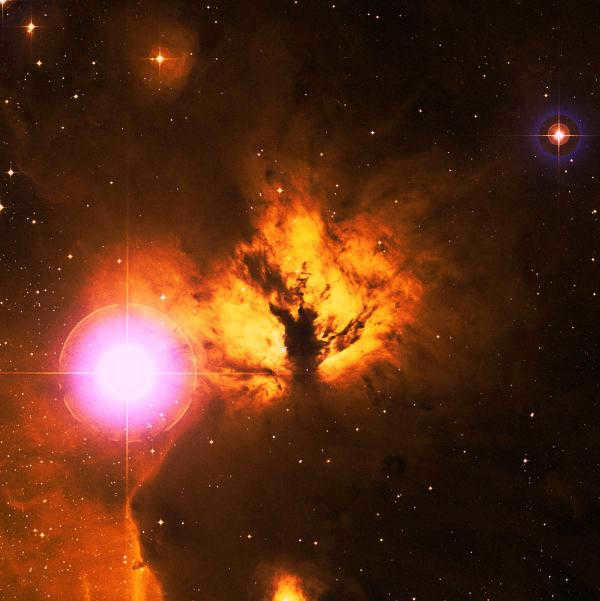
The Torch Nebula, also known as the Flame Nebula, possesses a unique and captivating beauty. It serves as yet another celestial location within the Orion constellation where the birth of new stars occurs continuously. When observed, its appearance bears a striking resemblance to a fierce fire, with luminous clouds dotted with dark flecks that emulate flames. Positioned in close proximity to Orion’s sigma star, the Torch Nebula is illuminated by its radiance. The distance that separates us from this sanctuary of youthful stars is approximately one thousand light years.
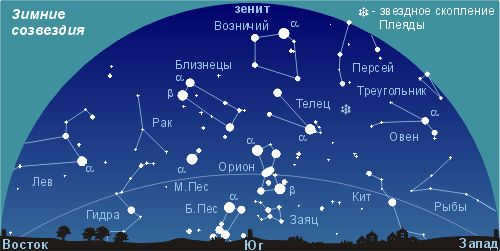
January’s celestial skies are renowned for their breathtaking beauty. To begin with, this month offers a spectacular showcase of unique constellations, including the magnificent Orion and Taurus, which ascend to their highest point in the sky. Additionally, January provides a prime opportunity to observe two of the most renowned nebulae in existence: the captivating Horsehead Nebula and the awe-inspiring Great Orion Nebula. Furthermore, stargazers are treated to the celestial splendor of the enchanting Seven Sisters, a cluster of stars that becomes visible during this time. Lastly, those residing in the southern hemisphere are granted the privilege of witnessing the renowned Large Magellanic Cloud, a celestial phenomenon that never fails to captivate.
Winter Skies Constellations December January February
The front tooth
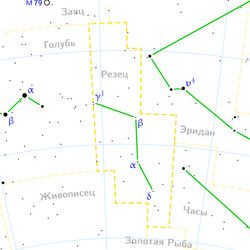
This small star group extends across the southern part of the celestial sphere. In terms of its expanse, Rezec ranks 81st, with an area measuring 125 square degrees. Out of all the stars within this constellation, only about two dozen are visible to the naked eye.
In shape, this star pattern resembles a fragmented line. To locate it in the night sky, one can use the bright star Fact (Alpha Dove) as a reference point and extend an imaginary line towards the Clock. Rezets can be found approximately in the middle of this line.
In Russia, the Rezets constellation can only be observed in the southern regions, specifically south of the 41st parallel. The optimal time for observation is during the month of December.
In the constellation Rezets, there are no particularly captivating celestial bodies. The stars themselves are the most intriguing. For instance, Alpha Rezza is a 4th magnitude spectral star located 66 light years away from Earth.
Gamma Rezza is a stellar system comprised of two binary stars: an orange luminary with a companion and a variable star accompanied by a white dwarf.
Regarding the far-off objects in Rezeca, two halakitics stand out: one with a spiral shape and another with an elliptical form.
Goldfish
Goldfish are small, colorful fish that are often kept as pets. They are known for their bright colors and unique patterns, which make them a popular choice for aquariums. Goldfish are native to East Asia and were first domesticated in China over a thousand years ago. They are a member of the carp family and are closely related to koi fish. In addition to their attractive appearance, goldfish are also known for their hardy nature and ease of care. They can adapt to a wide range of water conditions and are able to survive in both indoor and outdoor environments. Goldfish are omnivorous and will eat a variety of foods, including pellets, flakes, and live or frozen foods. They are social animals and thrive in the company of other goldfish. Goldfish have a relatively long lifespan, with some individuals living up to 20 years or more with proper care. Overall, goldfish are a popular and beloved pet for both experienced and novice fish keepers.
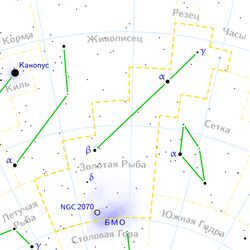
This slim constellation in the southern hemisphere covers an area of 179 square degrees in the sky and contains over 30 stars that can be observed without the need for optical instruments.
The constellation Goldfish is considered the most central constellation in the southern hemisphere, as it is where the south pole of the ecliptic is located. It can be located in the sky by focusing on the rhombus of the Grid. To the south, there are three bright stars that form a clear line. And the shape is completed by a triangle pointing towards the Flying Fish. Unfortunately, it is not possible to see the Goldfish in Russia. In the northern hemisphere, this constellation is only visible south of the 20th parallel.
Alpha Goldfish – is a prominent celestial object in the southern sky. It is a binary star system consisting of a blue-white giant and a white subgiant. Its stellar magnitude is 3, 30 mm.
Beta Goldfish can be found at the base of the triangle. This star exhibits variable brightness and undergoes a color change from blue to yellow.
The gamma of Goldfish marks the end of a straight line. This giant star belongs to a rare class of Cepheids and is known for its unique pulsation mechanism.
The Goldfish is most famous for hosting the primary satellite of our Milky Way, the Large Magellanic Cloud galaxy. Although classified as a dwarf galaxy, it contains over 400 nebulae, approximately 700 star clusters, and more than 1,000 stars, including numerous supergiants.
Mountains of the Tableland
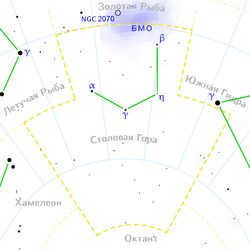
Table Mountain is a constellation located in the southern hemisphere, near the pole zone. Due to its proximity to the pole, it is not visible in the northern hemisphere, except for areas south of the 5th parallel. This makes it one of the least observed constellations, with only a few of its 24 stars visible to the naked eye, and most of them having a magnitude of 5 or smaller.
Covering an area of 153 square degrees in the sky, Table Mountain can be found by navigating through the neighboring constellations of South Hydra and Flying Fish. It sits between these two constellations, with Octanthus shining to the south and Goldfish to the north.
The four brightest stars in Table Mountain form a shape that resembles an inverted trapezoid. Interestingly, the constellation is named after a real geographic feature – Table Mountain, which is a mountain located in Africa.
The most luminous star in the constellation is its Alpha, a dwarf with a magnitude of 5 stars. One of the most remarkable stars is Pi of Table Mountain. This orange dwarf is accompanied by a massive gas exoplanet.
However, there are no faraway celestial objects in Table Mountain. Only the Large Magellanic Cloud touches the boundaries of this constellation.
Orion
Orion is a prominent constellation located on the celestial equator and visible throughout the world. It is one of the most recognizable and well-known constellations in the night sky. The name Orion comes from Greek mythology, where it represents a hunter who was turned into a constellation by the gods.
Orion is known for its distinctive shape, which resembles a figure with a belt and sword. The constellation is home to many fascinating celestial objects, including the famous Orion Nebula. This nebula is a stellar nursery, where new stars are born. It is one of the closest stellar nurseries to Earth and can be observed with the naked eye under dark skies.
In addition to the Orion Nebula, the constellation also contains several other notable objects. These include the bright stars Betelgeuse and Rigel, which are two of the brightest stars in the night sky. Betelgeuse is a red supergiant star nearing the end of its life, while Rigel is a blue supergiant star.
Orion is visible from both the northern and southern hemispheres, making it a popular constellation for stargazers around the world. It is best observed during the winter months in the northern hemisphere and the summer months in the southern hemisphere.
Overall, Orion is a fascinating and beautiful constellation that has captivated humans for centuries. Its unique shape and prominent position in the night sky make it a favorite among astronomers and stargazers alike.
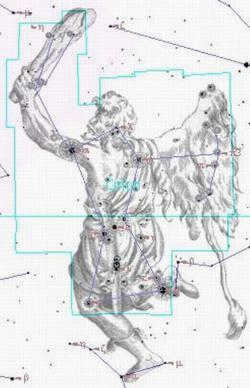
Orion is an equatorial constellation that is widely recognized for its beauty. It can be observed from August to April in the middle latitudes of the northern hemisphere, with the best viewing time being November through December.
What makes Orion particularly easy to identify is its famous Orion Belt, which consists of three stars aligned in a row. These stars serve as a reference point for other stars as well. By drawing a line from Orion’s Belt to the east, you will be directed towards the blue giant Sirius. On the other hand, if you follow Orion’s Belt to the west, it will lead you to the red star Aldebaran.
The arrangement of stars in the constellation bears a resemblance to the silhouette of a human figure. It is customary to identify several distinct parts, known as asterisms.
Orion’s BeltAs previously mentioned, this consists of three prominent stars that form a straight line. Each star has its own name: Mintaka, Alnilam, and Alnitak. These three stars are also referred to as the three sisters, the three wise men, or the rakes.
The Butterfly or the Sheaf – is another asterism that has a shape similar to a sundial. In addition to the stars mentioned above, it includes three more stars of varying magnitudes: Betelgeuse, Rigel, and Bellatrix.
Orion’s AlphaBetelgeuse is a red supergiant with a magnitude of zero. It is one of the brightest stars in the night sky, shining nearly 14,000 times brighter than the Sun.
Beta OrionRigel is a massive blue-white giant star with a magnitude of zero. It is renowned for its extraordinary brightness, as it radiates light that is 130,000 times more intense than that of the Sun.
The Orion constellation is also home to the renowned Orion Nebula, which was the first planetary nebula to be captured in a photograph by astronomers. Even with a telescope of moderate power, the Orion Nebula can be observed in all its glory. Another remarkable planetary nebula in the Orion constellation is known as the Horsehead Nebula due to its striking resemblance to the head of a horse.
Grid System
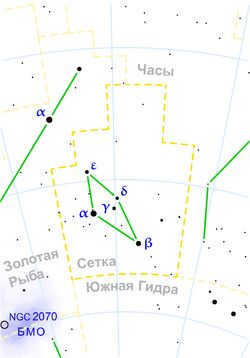
A magnificent constellation in the southern sky, resembling the shape of a diamond. It covers an area of 114 square degrees, within which more than twenty stars can be distinguished.
Locating the constellation in the night sky is not a challenging task, as its distinct shape stands out. To the south, Setka borders with the constellation South Fish, and to the north, it is adjacent to the constellation Clock. However, in Russia, it is impossible to observe Setka, as it can only be seen south of the 23rd parallel in the northern hemisphere.
Alpha Grid is an awe-inspiring yellow giant located 160 light years away from Earth. Beta Setka is a triple star system, with the primary component being a blue subgiant.
One of the most intriguing stars within Setka is Zeta Setka. It is a binary star consisting of two orange dwarfs, bearing a striking resemblance to our Sun.
Astronomers also study a spiral galaxy with a junction as part of the Setka constellation.
Taurus
The Bull
Taurus is the second astrological sign in the zodiac. It is represented by the symbol of a bull. People born between April 20 and May 20 are considered to be Taurus.
Taurus is ruled by the planet Venus, which is associated with love, beauty, and pleasure. This makes Taurus individuals known for their love of luxury and their appreciation for the finer things in life.
Taurus is an earth sign, which means that Taurus individuals are practical, grounded, and reliable. They are known for their determination and perseverance, and they often have a strong work ethic.
Taurus individuals are also known for their loyalty and their commitment to their relationships. They are often seen as dependable and trustworthy friends and partners.
Some famous Taureans include William Shakespeare, Adele, and George Clooney.
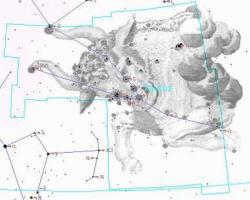
Taurus is an expansive and brilliantly shining constellation located in the northern hemisphere. It covers an impressive area of 797 square degrees, securing its rank as the 17th largest constellation. Among the 200 stars that can be observed in Taurus with the naked eye, nearly 10 stand out as some of the brightest.
Locating the constellation of Taurus in the night sky is a relatively simple task. By using Orion’s Belt as a guide, one can easily spot Aldeberan – the brightest star in Taurus. In close proximity, you’ll find the constellations of Gemini and Aries.
This particular constellation is considered a non-setting constellation, meaning it can be observed in Russia from August to April. Taurus is especially prominent in the middle latitudes.





